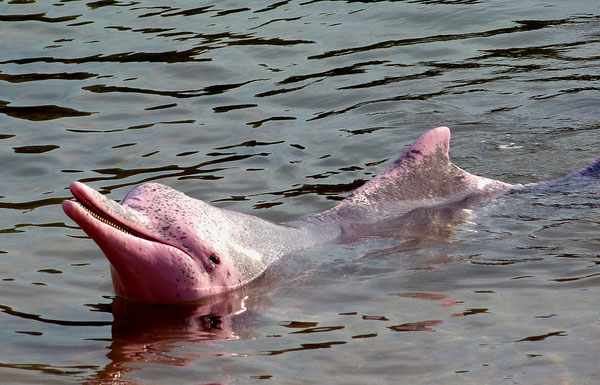- Talk with an expert insider!
- USA & Canada: 1-773-280-9571
- Ecuador: +593-987-004-404
- [email protected]

Amazon Rainforest Pink Dolphin

Indigenous Communities of the Amazon Rainforest
September 11, 2018
Bartolome Island, Galapagos
September 28, 2018The wildlife in Ecuador is simply amazing, with its Galapagos islands where people taking a Galapagos cruise or a land based tour can see a huge array of species, to the Amazon region of Ecuador where one of the most exciting possibilities of a visit to the Amazon Rainforest is the chance to spot the Amazon Rainforest pink dolphin. The Amazon pink dolphin is actually named the Amazon river dolphin or the pink river dolphin. It is sometimes known simply as “boto”. This aquatic creature may only be found in freshwater environments, and it is different from the marine pink dolphin. Specifically, the pink dolphin usually lives in the Amazon region of South America, and it has been observed in Ecuador, Peru, Bolivia, Brazil, Colombia, Venezuela and Guyana. In addition to the Amazon River basin, it can also be found in the Orinoco river basin.
Amazon Rainforest Pink Dolphin Facts
Amazon river dolphins typically weigh up to 352 pounds. They grow up to 9.2 feet in length. Interestingly, while the dolphin is named after its pink color, actually when it is young it is gray. The dolphin develops its pink color as it grows older. Some do not change too much, while others develop just pink spots. Other individuals may become a very bright pink color. They may also turn even pinker when they become excited. The color of this dolphin can depend on a variety of factors such as diet, how much sunlight they are exposed to and behavior, as well as placement of their capillaries, though experts are not completely sure of the factors that lead to their unusual coloration. Adult males tend to turn the pinkest color.
Mythology around the pink dolphin sometimes suggests that they are blind. This is not the case. While the Amazon pink dolphin has rather small round eyes, they do have very good eyesight. Lifespan is believed to be just under three years in the wild, on average. In captivity these creatures can achieve a much greater longevity, and have been known to have lived for up to 30 years. However, some river dolphins have not done well in captivity, so a longer lifespan is certainly not guaranteed this way.
Communication between pink river dolphins is achieved through whistling tones that are not audible to humans. The evidence suggests that these sounds are different to those made by other types of dolphins.

Amazon Pink Dolphin Behavior
While other species of dolphin may spend their time in larger groups, the pink river dolphin prefers to spend its time either alone or in groups of just two to four creatures. Occasionally they may be spotted in larger groups if there is a lot of food in a particular area. They tend to live in whitewater, clearwater and blackwater rivers that are fast flowing, but they can also be found in lakes, major tributaries and sometimes in flooded rainforests in the rainy season.
Similarly to marine dolphins, the Amazon pink dolphin will interact with people. This is because they have a naturally inquisitive nature, and they are rather outgoing. They do not often leap above the water, as marine dolphins may be seen to do. Interestingly, they do seem to like swimming upside down. The reason for this is believed to be so that they can keep an eye on what is going on below them in the murky depths of the Amazon River.
Amazon river dolphins are active during the daytime, and are most likely to be seen any time from early in the morning until late afternoon. When they sleep, they do so with one eye open. Their diet is mostly comprised of fish, but they may also eat turtles, crabs and shellfish. To attract a mate, the males will carry branches or other items in their mouths to suggest to the females that they would like to mate. They breed seasonally and have their pups in May and June time. This is when there is flooding in their habitat, and this gives the female and its babies the best chance of survival.
Pink river dolphin conservation
Concerns have been raised about the Amazon river dolphin. There is not sufficient data available on this species to know the extent to which it is at risk. However, there have been issues brought up associated with a number of threats, such as hunting, the reduction of this creature’s habitat, and the fact that some individuals get caught up in fishing lines. From a more positive perspective, these dolphins have been the subject of a good deal of mythology. In some cases, they are considered somewhat magical, and this has been good for their preservation from danger by people.

Observing the Amazon pink dolphin
Amazon Rainforest Pink river dolphins are sometimes seen during trips to the Amazon Rainforest. At Ecuador and Galapagos Insiders we can help you identify a trip where you will have the chance of spotting this fascinating creature. One of our favorite Ecuadorian lodges has reported various dolphins swimming closeby in past weeks including the months of July and August 2020, Sacha Lodge can be a perfect option for a luxurious lodge trip and that could allow you to get to see a huge array of wildlife including the incredible river pink dolphins. Get in touch now for more information and advice on the best places to visit in the Ecuadorian Amazon region.






